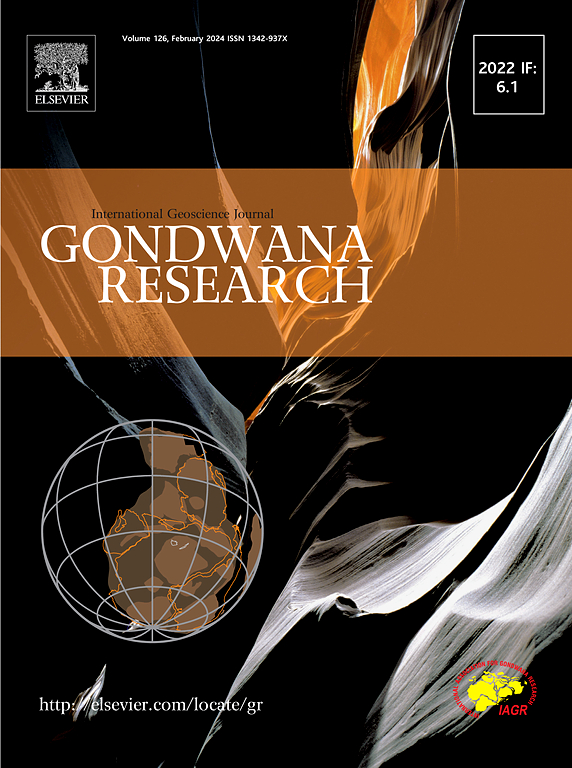Decoding cycling and enrichment of boron and associated lithium in waters of the Tibetan Plateau with boron isotopes
IF 7.2
1区 地球科学
Q1 GEOSCIENCES, MULTIDISCIPLINARY
引用次数: 0
Abstract
The Tibetan Plateau (TP), which has various water bodies exhibiting extreme enrichment of boron (B), lithium (Li) and other elements, is a unique and cost-effective supplier of B and Li globally. However, the sources and enrichment mechanisms of these elements remain disputed. Herein, big data on B isotopes and geochemistry were compiled to reveal cycling and enrichment of B and associated Li in the complex mountain-basin systems of the TP. Various water bodies on the TP show remarkably high B and Li concentrations compared with the global average levels. B and Li are supernormally enriched or even mineralized in some salt lakes, oilfield brines, and geothermal systems. Water with high B concentrations exhibits simultaneous 11B depletion. The spatial patterns of B-Li concentrations and δ11B values are characterized by a westward increase and a southward decrease, respectively. The mechanisms of B and Li cycling and enrichment, from source to sink, on the TP can be summarized as follows: 1) Slab subduction and following continental collisions induced partial melting of the mid-lower crust, resulting in late-stage highly differentiated crust-derived magma upwelling and invasion into the mid-upper crust. Hot springs thereby maintain an efficient release of abnormally abundant B and Li from magmatic fluids to the surface through deep geothermal circulation. 2) In the eastern and southeastern TP, Massive degassing of mantle fractions prevails along large strike-slip faults. B and Li enriched from mantle- or crust-derived fluids can reach the surface via local volcanism. 3) Water-rock interaction and weathering trigger further activation, mobilization, and enrichment of B and Li in water. The aforementioned geological processes supply constantly deep-source B and Li to rivers and groundwater as cold-hot springs. Eventually, B and Li are fed into the lake basin jointly with supergene processes; after prolonged evaporation-concentration, excellent B-Li-rich salt lake resources are formed.

用硼同位素解析青藏高原水体中硼和伴生锂的循环富集
青藏高原(TP)拥有硼(B)、锂(Li)等元素极度富集的多种水体,是全球独特且具有成本效益的B和Li供应地。然而,这些元素的来源和富集机制仍存在争议。利用B同位素和地球化学大数据,揭示了青藏高原复杂山盆体系中B和伴生Li的循环富集规律。与全球平均水平相比,TP上各水体的B、Li浓度均显著升高。B和Li在一些盐湖、油田盐水和地热系统中异常富集甚至矿化。高B浓度的水同时表现出11B的耗竭。B-Li浓度和δ11B值的空间分布特征分别为向西增加和向南减少。TP上B、Li从源到汇的循环富集机制可概括为:1)板块俯冲和随后的大陆碰撞导致中下地壳部分熔融,导致晚期高分异的壳源岩浆上涌侵入中上地壳。因此,温泉通过深层地热循环,使异常丰富的B和Li从岩浆流体中有效地释放到地表。2)在青藏高原东部和东南部,沿大型走滑断层,地幔组分大量脱气。地幔或地壳流体富集的B和Li可通过局部火山作用到达地表。3)水岩相互作用和风化作用促使水中B、Li进一步活化、动员和富集。上述地质过程不断以冷热泉的形式向河流和地下水提供深源B和Li。最终,B、Li与表生作用共同进入湖盆;经过长时间的蒸发浓缩,形成了优良的富b - li盐湖资源。
本文章由计算机程序翻译,如有差异,请以英文原文为准。
求助全文
约1分钟内获得全文
求助全文
来源期刊

Gondwana Research
地学-地球科学综合
CiteScore
12.90
自引率
6.60%
发文量
298
审稿时长
65 days
期刊介绍:
Gondwana Research (GR) is an International Journal aimed to promote high quality research publications on all topics related to solid Earth, particularly with reference to the origin and evolution of continents, continental assemblies and their resources. GR is an "all earth science" journal with no restrictions on geological time, terrane or theme and covers a wide spectrum of topics in geosciences such as geology, geomorphology, palaeontology, structure, petrology, geochemistry, stable isotopes, geochronology, economic geology, exploration geology, engineering geology, geophysics, and environmental geology among other themes, and provides an appropriate forum to integrate studies from different disciplines and different terrains. In addition to regular articles and thematic issues, the journal invites high profile state-of-the-art reviews on thrust area topics for its column, ''GR FOCUS''. Focus articles include short biographies and photographs of the authors. Short articles (within ten printed pages) for rapid publication reporting important discoveries or innovative models of global interest will be considered under the category ''GR LETTERS''.
 求助内容:
求助内容: 应助结果提醒方式:
应助结果提醒方式:


